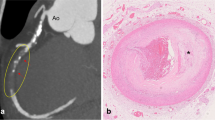Abstract
Postmortem CT (PM-CT) is useful to investigate the viscera in situ before opening the body cavities at autopsy. The present study involved a virtual morphometric analysis of thoracic and abdominal great vessels with regard to the cause of death as a possible index of terminal circulatory status in forensic autopsy cases, using PM-CT data of forensic autopsy cases within 3 days postmortem (n = 93). Perimeters and cross-sectional areas of the aorta and vena cava depended on the age and/or gender of subjects; however, when the vessel flattening index (vFI) was calculated as the ratio of the cross-sectional area (a) to the estimated circle area having the same perimeter (l), using the formula vFI = 4πa/l2, the vFI showed distinct differences among the causes of death without significant postmortem time dependence. The index was low for each vessel in fatal bleeding, while the vFI of the abdominal aorta and inferior vena cava was low in hyperthermia (heatstroke), but higher in drowning, hypothermia (cold exposure) and sudden cardiac death. These CT findings provide quantitative data as supplementary indicators to reinforce autopsy findings for interpreting terminal circulatory status.







Similar content being viewed by others
References
Thali MJ, Yen K, Vock P, Ozdoba C, Kneubuehl BP, Sonnenschein M, Dirnhofer R (2003) Image-guided virtual autopsy findings of gunshot victims performed with multi-slice computed tomography and magnetic resonance imaging and subsequent correlation between radiology and autopsy findings. Forensic Sci Int 138(1–3):8–16
Bolliger SA, Thali MJ, Ross S, Buck U, Naether S, Vock P (2008) Virtual autopsy using imaging: bridging radiologic and forensic sciences: a review of the Virtopsy and similar projects. Eur Radiol 18(2):273–282
Shiotani S, Kohno M, Ohashi N, Yamazaki K, Nakayama H, Watanabe K, Oyake Y, Itai Y (2004) Non-traumatic postmortem computed tomographic (PMCT) findings of the lung. Forensic Sci Int 139(1):39–48
Leth PM (2009) Computerized tomography used as a routine procedure at postmortem investigations. Am J Forensic Med Pathol 30(3):219–222
Sogawa N, Michiue T, Kawamoto O, Oritani S, Ishikawa T, Maeda H (2014) Postmortem virtual volumetry of the heart and lung in situ using CT data for investigating terminal cardiopulmonary pathophysiology in forensic autopsy. Leg Med (Tokyo) 16(4):187–192
Sogawa N, Michiue T, Ishikawa T, Kawamoto O, Oritani S, Maeda H (2014) Postmortem volumetric CT data analysis of pulmonary air/gas content with regard to the cause of death for investigating terminal respiratory function in forensic autopsy. Forensic Sci Int 241:112–117
Michiue T, Sakurai T, Ishikawa T, Oritani S, Maeda H (2012) Quantitative analysis of pulmonary pathophysiology using postmortem computed tomography with regard to the cause of death. Forensic Sci Int 220(1–3):232–238
Sakurai T, Michiue T, Ishikawa T, Yoshida C, Sakoda S, Kano T, Oritani S, Maeda H (2012) Postmortem CT investigation of skeletal and dental maturation of the fetuses and newborn infants: a serial case study. Forensic Sci Med Pathol 8(4):351–357
Michiue T, Ishikawa T, Oritani S, Kamikodai Y, Tsuda K, Okazaki S, Maeda H (2013) Forensic pathological evaluation of postmortem pulmonary CT high-density areas in serial autopsy cases of sudden cardiac death. Forensic Sci Int 232(1–3):199–205
Christe A, Flach P, Ross S, Spendlove D, Bolliger S, Vock P, Thali MJ (2010) Clinical radiology and postmortem imaging (Virtopsy) are not the same: specific and unspecific postmortem signs. Leg Med (Tokyo) 12(5):215–222
Ishikawa N, Nishida A, Miyamori D, Kubo T, Ikegaya H (2013) Estimation of postmortem time based on aorta narrowing in CT imaging. J Forensic Led Med 20(8):1075–1077
Takahashi N, Higuchi T, Hirose Y, Yamanouchi H, Takatsuka H, Funayama K (2013) Changes in aortic shape and diameters after death: comparison of early postmortem computed tomography with antemortem computed tomography. Forensic Sci Int 225(1–3):27–31
Aghayev E, Sonnenschein M, Jackowski C, Thali M, Buck U, Yen K, Bolliger S, Dirnhofer R, Vock P (2006) Postmortem radiology of fatal hemorrhage: measurements of cross-sectional areas of major blood vessels and volumes of aorta and spleen on MDCT and volumes of heart chambers on MRI. AJR Am J Roentgenol 187(1):209–215
Rogers IS, Massaro JM, Truong QA, Mahabadi AA, Kriegel MF, Fox CS, Thanassoulis G, Isselbacher EM, Hoffmann U, O′Donnell CJ (2013) Distribution, determinants, and normal reference values of thoracic and abdominal aortic diameters by computed tomography (from the Framingham Heart Study). Am J Cardiol 111(10):1510–1516
Akobeng AK (2007) Understanding diagnostic tests 3: receiver operating characteristic curves. Acta Paediatr 96(5):644–647
Martin C, Sun W, Primiano C, McKay R, Elefteriades J (2013) Age-dependent ascending aorta mechanics assessed through multiphase CT. Ann Biomed Eng 41(12):2565–2574
Hager A, Kaemmerer H, Rapp-Bernhardt U, Blücher S, Rapp K, Bernhardt TM, Galanski M, Hess J (2002) Diameters of the thoracic aorta throughout life as measured with helical computed tomography. J Thorac Cardiovasc Surg 123(6):1060–1066
Conflict of interest
The authors have no conflict of interest.
Author information
Authors and Affiliations
Corresponding author
Electronic supplementary material
Below is the link to the electronic supplementary material.
ESM 1
(PDF 41 kb)
Rights and permissions
About this article
Cite this article
Sogawa, N., Michiue, T., Ishikawa, T. et al. Postmortem CT morphometry of great vessels with regard to the cause of death for investigating terminal circulatory status in forensic autopsy. Int J Legal Med 129, 551–558 (2015). https://doi.org/10.1007/s00414-014-1075-0
Received:
Accepted:
Published:
Issue Date:
DOI: https://doi.org/10.1007/s00414-014-1075-0




